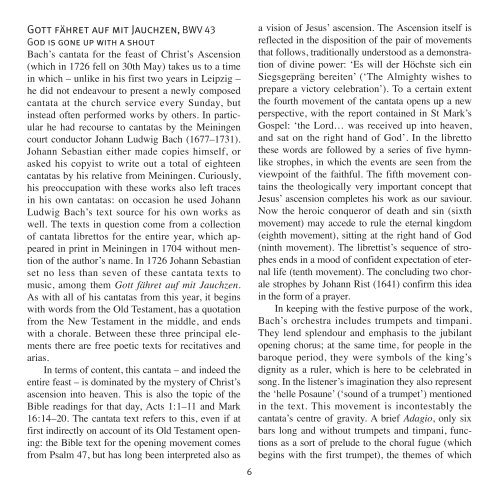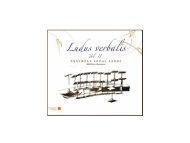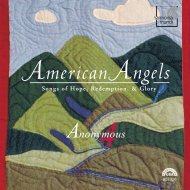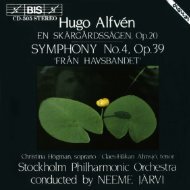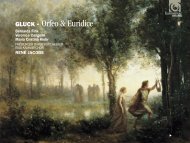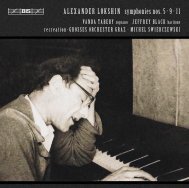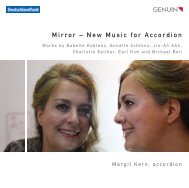Album booklet - eClassical
Album booklet - eClassical
Album booklet - eClassical
You also want an ePaper? Increase the reach of your titles
YUMPU automatically turns print PDFs into web optimized ePapers that Google loves.
Gott fähret auf mit Jauchzen, BWV 43<br />
God is gone up with a shout<br />
Bach’s cantata for the feast of Christ’s Ascension<br />
(which in 1726 fell on 30th May) takes us to a time<br />
in which – unlike in his first two years in Leipzig –<br />
he did not endeavour to present a newly composed<br />
cantata at the church service every Sunday, but<br />
instead often performed works by others. In par tic -<br />
ular he had recourse to cantatas by the Mei ningen<br />
court conductor Jo hann Ludwig Bach (1677–1731).<br />
Johann Sebastian either made copies him self, or<br />
asked his copyist to write out a total of eigh teen<br />
can tatas by his relative from Mei ningen. Curi ously,<br />
his preoccupation with these works also left traces<br />
in his own cantatas: on occa sion he used Jo hann<br />
Ludwig Bach’s text source for his own works as<br />
well. The texts in ques tion come from a collec tion<br />
of cantata lib rettos for the entire year, which ap -<br />
peared in print in Meiningen in 1704 without men -<br />
tion of the author’s name. In 1726 Johann Sebastian<br />
set no less than seven of these cantata texts to<br />
music, among them Gott fähret auf mit Jauchzen.<br />
As with all of his cantatas from this year, it begins<br />
with words from the Old Testament, has a quota tion<br />
from the New Testament in the middle, and ends<br />
with a chorale. Between these three prin cipal ele -<br />
ments there are free poetic texts for recit a tives and<br />
arias.<br />
In terms of content, this cantata – and indeed the<br />
entire feast – is dominated by the mystery of Christ’s<br />
ascension into heaven. This is also the topic of the<br />
Bible readings for that day, Acts 1:1–11 and Mark<br />
16:14–20. The cantata text refers to this, even if at<br />
first indirectly on account of its Old Tes ta ment open -<br />
ing: the Bible text for the open ing move ment comes<br />
from Psalm 47, but has long been interpreted also as<br />
6<br />
a vision of Jesus’ ascen sion. The Ascension itself is<br />
reflected in the disposition of the pair of movements<br />
that follows, traditionally under stood as a demon stra -<br />
tion of divine power: ‘Es will der Höchste sich ein<br />
Siegs gepräng bereiten’ (‘The Almighty wishes to<br />
pre pare a victory celebration’). To a certain extent<br />
the fourth movement of the can tata opens up a new<br />
perspective, with the report con tained in St Mark’s<br />
Gospel: ‘the Lord… was received up into heaven,<br />
and sat on the right hand of God’. In the libretto<br />
these words are followed by a series of five hymnlike<br />
strophes, in which the events are seen from the<br />
viewpoint of the faithful. The fifth movement con -<br />
tains the theologically very important concept that<br />
Jesus’ ascension completes his work as our saviour.<br />
Now the heroic conqueror of death and sin (sixth<br />
movement) may accede to rule the eternal kingdom<br />
(eighth movement), sitting at the right hand of God<br />
(ninth movement). The librettist’s sequence of stro -<br />
phes ends in a mood of confident expectation of eter -<br />
nal life (tenth move ment). The concluding two chor -<br />
ale strophes by Johann Rist (1641) confirm this idea<br />
in the form of a prayer.<br />
In keeping with the festive purpose of the work,<br />
Bach’s orchestra includes trumpets and tim pani.<br />
They lend splendour and emphasis to the jubilant<br />
opening chorus; at the same time, for people in the<br />
baroque period, they were symbols of the king’s<br />
dignity as a ruler, which is here to be celebrated in<br />
song. In the listener’s imagination they also repre sent<br />
the ‘helle Posaune’ (‘sound of a trumpet’) mentioned<br />
in the text. This movement is incon test ably the<br />
cantata’s centre of gravity. A brief Adagio, only six<br />
bars long and without trum pets and tim pani, func -<br />
tions as a sort of pre lude to the choral fugue (which<br />
begins with the first trumpet), the themes of which


